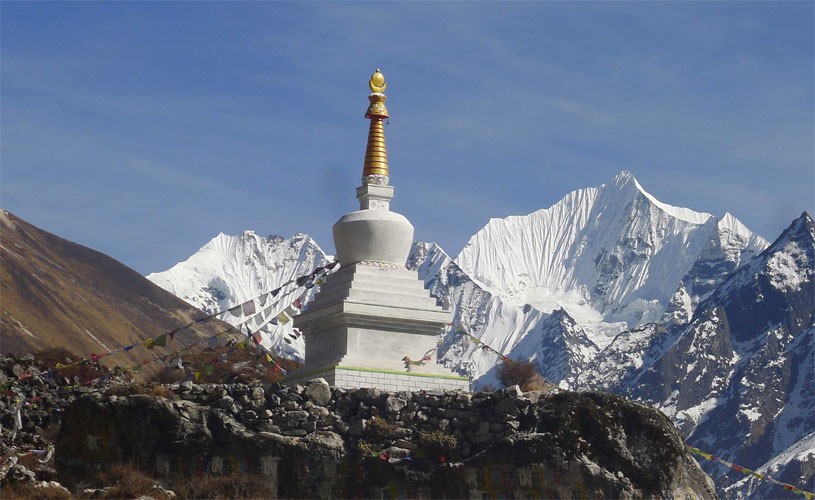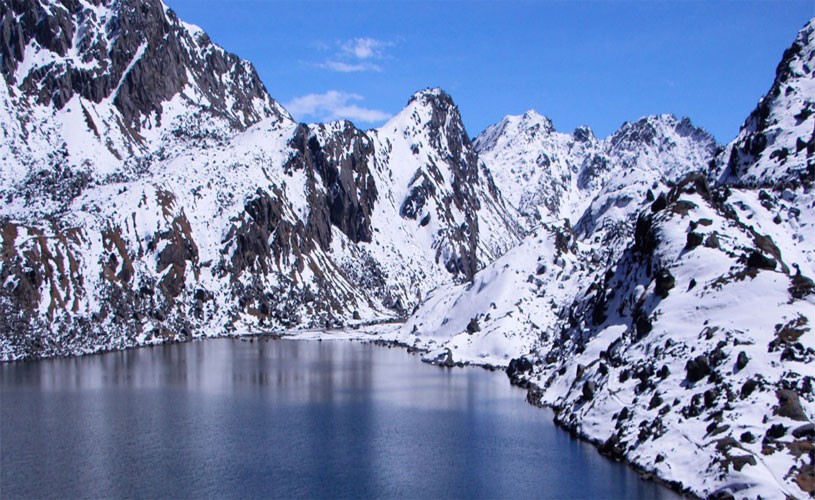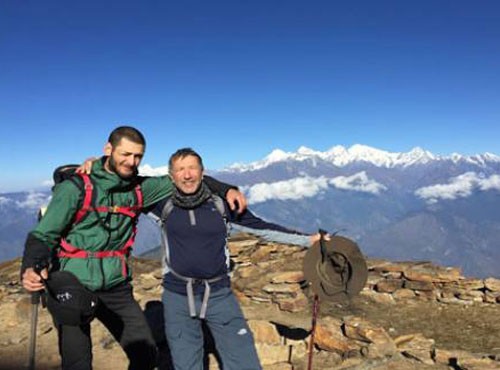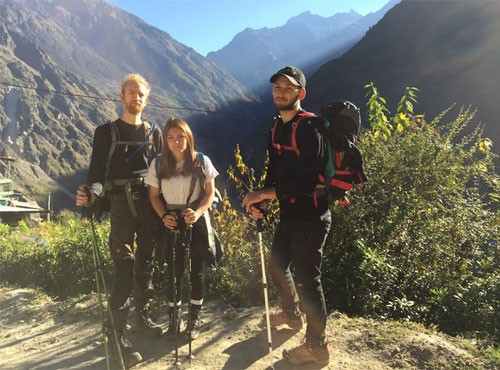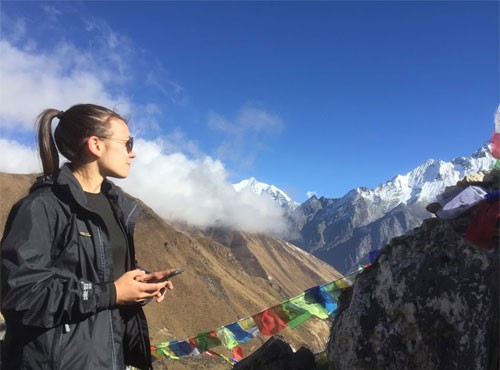Langtang Gosainkunda Trip Highlights:
- UNESCO World Heritage Sites tour in Kathmandu
- A pleasant drive from Kathmandu to Syabrubesi
- A combination of landmarks, Langtang, Gosainkunda and Helambu
- Trek in the less crowded region near Kathmandu Valley
- Diverse scenic elements include forests, rivers, alpine forests, pastureland, yak
- Langtang encompasses sacred high-altitude Gosainkunda Lake
- Panoramic view of Langtang Ri, Langtang Himal and , Ganjala Peak
- Experience the beautiful cultures of Indigenous Tamang
- Old Buddhist shrines — Kyangjing Gompa
- Laurebina Pass (4,610m), the highest point on the route
- Trek through ancient villages, pastureland, and farmland in Helambu
Langtang, Gosainkunda and Helambu Trek Overview
The Langtang, Gosaikunda, and Helambu Trek is a captivating 17-day adventure through Nepal's breathtaking landscapes, combining lush forests, charming villages, diverse wildlife, and awe-inspiring Himalayan vistas. The journey begins in Kathmandu with visits to the city's UNESCO World Heritage Sites, offering a cultural prelude before heading to Syabrubesi, a picturesque Tamang village by the Bhote Koshi River. The trek unfolds with a visit to Kyanjin Gompa, followed by a climb to Tserko Ri, where trekkers are rewarded with magnificent views of the Langtang Lirung (7,200m/23,622ft) range. Traversing the enchanting Langtang Valley, the trek reaches Gosaikunda, a sacred pilgrimage site for Buddhists and Hindus, renowned for the sparkling Gosaikunda Lake, whose waters are believed to possess magical healing properties. Along the way, trekkers pass several other serene lakes and cross the formidable Laurebina Pass, marking the transition into the Helambu Valley.
In the Helambu region, the adventure continues with a trek to the summit of Ama Yangri (3,800m), where panoramic views of the Himalayas rival the famous vistas from Poon Hill. From this vantage point, the Langtang ranges and Mt. Shishapangma feels remarkably close, almost within reach. The trek winds through the Helambu Valley, offering a mix of cultural immersion and natural beauty, before concluding with a scenic drive back to Kathmandu. This remarkable journey blends cultural exploration with unforgettable mountain experiences, making it a perfect choice for those seeking both spiritual and natural wonders in the heart of the Himalayas.
Langtang, Gosainkunda, and Helambu Treks encompass the experience of the Himalayas, high-altitude lakes, and the beautiful cultures of different ethnic groups, including the Sherpas, Tamangs, Yolmus, and Bhotias. Langtang, known as the ‘Lake Region, has over 70 glaciers and high-altitude lakes, including Gosainkunda, Parvatikunda, Bhairavkunda, and Dudhkunda. The route of Langtang, Gosainkunda, and Helambu Trek passes through Langtang National Park, home to many varieties of natural vegetation, wild mammals, and different species of birds.
The rugged terrains pass through the bamboo forests, oaks, pines, and maples surrounding Langtang River Gorge and Langtang National Park. The first day of the foot trail halts at Lama Hotel, and the second day at Kyangjin Gompa, the main monastery in the region. The Kyangjin Gompa offers fantastic views of Langtang Lirung (7,200m/23,622ft) range. The most significant Tamang settlement, enriched by Tibetan culture, tradition, an ancient trading style, and the hardships of their lifestyle, can be explored in Langtang Valley. Exploring the monastery and its locality also provides an opportunity to acclimate well.
The trail to Gosainkunda is traced after getting back to the Lama Hotel. The three consecutive days of hiking through forests, scenic foothills, and ridgeline landscape take one to sacred Gosainkunda Lake (4,300m), regarded as holy in Hinduism and Buddhism. The devotees and revelers believe that the Hindu God Shiva formed the lake. Thousands of pilgrims from India and people in Nepal visit the lake for rituals, especially on the occasion of ‘Janai Purnima’ to mark the Full Moon festival that usually falls in the third week of August.
The Trek in the Helambu region begins after crossing Laurebina Pass. The Trek continues through rhododendron forest, pastureland, and a Tahrepati village on the base of yet another pass called Tharepati Pass (3,490m). The fantastic view of Jugal Himal and its surroundings inspires all who witness to advance. The foot trail epic continues through ancient villages, pastureland, and farmland in Helambu for three consecutive days and concludes at Melamchi Pul Bazaar. The overland journey from Melamchi Pul Bazaar to Kathmandu completes the Langtang, Gosainkunda, and Helambu Trek.
Best Time for Trekking in the Langtang Region
The Langtang region offers incredible trekking experiences throughout the year, but choosing the right season can greatly enhance your journey.
When to Trek
Best Time: October to May (dry season)
Challenging Time: June to September (monsoon season)
During the monsoon, trekking can be difficult due to heavy rain, muddy trails, and leeches. However, some trekkers prefer this season for its quiet trails and lush landscapes, as there are fewer visitors.
Autumn Season (September to December)
Autumn is the most popular time for trekking in Nepal. From mid-September to mid-December, the weather is clear and stable, making it ideal for trekking. The skies are washed clean by monsoon rains, offering spectacular views of the mountains. Temperatures are mild, and the trails are dry and comfortable. However, December can bring colder temperatures and snow at higher altitudes, so proper preparation is essential.
Spring Season (February to May)
Spring is another excellent time for trekking. The trails come alive with blooming rhododendrons and other wildflowers, adding vibrant colors to the scenery. Although visibility can be slightly reduced due to dust in the air, the mild temperatures and beautiful landscapes more than compensate for it. This season is perfect for both trekking and exploring the natural beauty of the Langtang region.
Meals During the trek
Breakfast, lunch, and dinner will be provided during the trek, and breakfast will only be provided in Kathmandu. We host welcome and farewell dinners for our guests. During the trek, we have breakfast and dinner at tea houses or lodges where we spend nights, and lunch at tea houses will be served on the way. You have the option to choose from Nepali, continental, Tibetan, and Indian cuisines. As we care for our guests, we ensure you are getting healthy food. We prioritize locally produced organic food and also provide you with seasonable fruits. During the climbing session, hygienic, freshly cooked food will be provided.
Note: If you are a vegetarian, let us know in advance so that we can make proper arrangements for food as per your wish during the trek
Accommodation during the Trip
You will be accommodated in a three-star standard hotel in Kathmandu and the best available teahouses during the trek. All accommodations are on a twin-shared basis. A single supplement will be served on request and will cost an additional. Since you will be trekking in remote regions, the services in the teahouses/guesthouse will be essential. We will try our best to arrange rooms with attached washrooms; however, some teahouses still need attached bathrooms.
Drinking Water during the Trip
Adventure Club provides all the meals on the trek but needs to provide Water. The best option is to treat the local Water with chlorine/iodine tablets or a steripen. The tea houses will give you good quality free water, and you can also get along the trail, but you will need to treat it. If you use the tablets, make sure they dissolve completely (about 30 mins). On most treks, you can buy mineral water along the trail. A liter of mineral water at lower-elevation tea houses costs around USD 1, but at higher elevations, it can cost up to $4, so the cost can add up.

